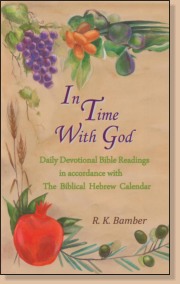Home
The book, “In Time With God”, by R K Bamber is a ‘page a day’ daily devotional, which gives you readings for each day of the year, drawing on the Old and New Testaments.
It is unique in that it uses the Biblical ‘Hebraic’ Calendar, rather than the Gregorian ‘Roman’ Calendar of January to December. This is to enable believers in Jesus to align and connect with the current day in the Bible, according to the Jewish root of the Christian faith.
It is simple and easy to use. To find today’s page in the book, get the Hebrew date for today, shown on this page. Then turn to the page in the book which is titled with this date.
Alternatively, you can download the free calendar for this year from the Downloads Page of this website, or purchase one to be mailed to you in the post, available on the Shop Page of this website.
Why use the Biblical ‘Hebraic’ Calendar?

The problem we have is that our Gregorian calendar year of January through to December does not correlate with the Bible and dates used in the Bible. So, for example, when the Bible tells us that the Feast of Passover begins on the 14th Day of the first month, the 14th day of Nisan, most people, unless they are observant Jews, do not know when that is. It falls on a different day of the Gregorian calendar each year and can be anywhere in March or April.
This means we often ‘miss’ the day when it comes, unless we have a Hebrew calendar and know what the date is.
Why is it important to know the dates of the Feasts in the Bible?
The dates of the Biblical Feasts, called the ‘Feasts of the Lord’ in Leviticus 23:2, are referred to as ‘Moedim’ in Hebrew, which means ‘Appointed Times’. They were days, given to Moses for special worship, and with specific instructions, for a purpose. This is because they are prophetic. For example, the symbolism of the Passover was fulfilled by Jesus at the Last Supper which was a Passover Meal, and the Feast of First Fruits was fulfilled by Jesus when He rose from the dead on that day. The Holy Spirit was given on the Feast of Weeks, Pentecost. The autumn feasts of Trumpets, Yom Kippur and Tabernacles are going to be fulfilled in the last days.
The One New Man of Jewish and Gentile believers in Jesus
Traditionally the predominantly Gentile Churches have kept Christmas and Easter and other seasons on the Church Calendar which has its roots in Romanism. However, the earlier Hebraic Calendar, observed by Jesus and His disciples, is Jewish. Therefore, it does not make sense, when a Jew discovers Jesus as the Jewish Messiah, for him to abandon the Jewish Feasts which were kept by Jesus. Similarly, when a Gentile discovers Jesus as his Messiah, there is a journey to be made to discover the Jewish Feasts and culture of the Bible and of Jesus. The two come together as one, according to the verse in Ephesians 3:15, which speaks of ‘One New Man’ in Jesus, when we have the same Messiah, and the dividing wall is gone. For this reason, the daily readings in the book use the Hebrew form of the name Jesus - ‘Yeshua’,
“In Time With God” helps the reader to understand more clearly what it means to be part of the ‘One New Man’ and to actively live and walk within the times and seasons of the Bible. It will enrich their understanding of how the Old and New Testaments connect together, and will make sense of passages in the Bible which appeared confusing without this understanding. It will help the reader to not miss the richness of the Word of God, and will help them grow in their personal faith and relationship with God.

